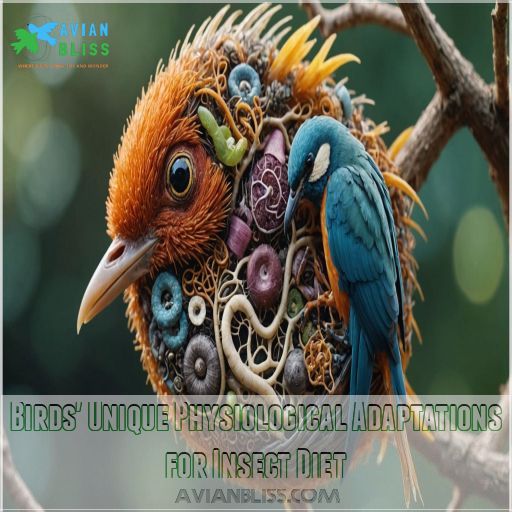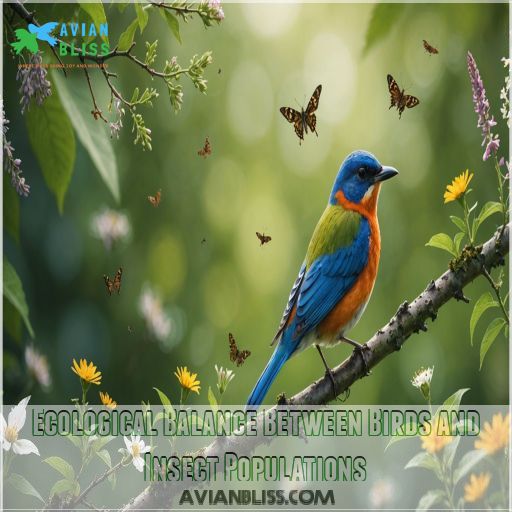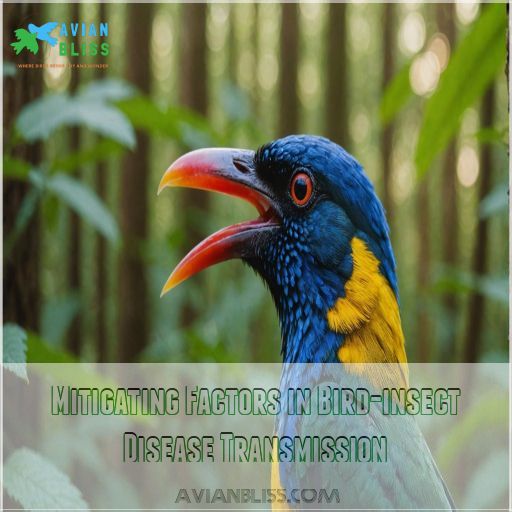This site is supported by our readers. We may earn a commission, at no cost to you, if you purchase through links.
 You’re wondering why birds don’t get diseases from munching on bugs all day? Well, they’ve got a killer combo of defenses!
You’re wondering why birds don’t get diseases from munching on bugs all day? Well, they’ve got a killer combo of defenses!
Birds have a robust immune system, complete with a higher body temperature that acts like a natural fever, scaring off many pathogens.
Their efficient digestive system works lightning fast, flushing out potential nasties before they cause trouble.
Plus, their diet is diverse, so they aren’t stuck eating one type of insect that might carry disease. It’s like having a personal health squad and a super-speed conveyor belt in their bellies!
Curious about how these amazing adaptations evolved? There’s more to discover!
Table Of Contents
- Key Takeaways
- Birds’ Robust Immune Defenses Against Insect-borne Pathogens
- Efficient Digestive System Minimizes Pathogen Exposure
- Birds’ Unique Physiological Adaptations for Insect Diet
- Ecological Balance Between Birds and Insect Populations
- Mitigating Factors in Bird-insect Disease Transmission
- Frequently Asked Questions (FAQs)
- Conclusion
Key Takeaways
- Birds have a "killer combo" for staying healthy while dining on bugs, thanks to their robust immune systems. Their higher body temperature acts like a natural fever, warding off pathogens, much like a built-in sauna session that kills germs.
- Their digestive systems are like speedy rollercoasters, quickly processing food and minimizing pathogen exposure. Birds’ stomachs are super-efficient, kicking out harmful invaders before they can settle in, like a fast-moving conveyor belt on a mission.
- Evolution has gifted birds with specialized tools for insect consumption. Think of their beaks and tongues as perfectly designed instruments for catching insects mid-air, making each meal a precise operation rather than a chaotic smorgasbord.
- By snacking on a variety of bugs, birds maintain a balanced diet, reducing their chances of encountering any single pest that might harbor a disease. It’s like having an endless buffet with plenty of safe options—keeping them healthy and keeping their immune systems sharp.
Birds’ Robust Immune Defenses Against Insect-borne Pathogens
As you watch birds devouring insects in your backyard, you might wonder how they avoid getting sick.
Their secret lies in a robust immune system, equipped with specialized cells, organs, and a higher body temperature that inhibits the growth of many pathogens.
This unique combination allows them to enjoy their bug buffet without falling ill.
Innate and Adaptive Immunity in Birds
Innate and Adaptive Immunity in Birds (Birds’ Robust Immune Defenses Against Insect-borne Path)
You’re probably wondering how birds stay healthy despite their bug-filled diets.
The answer lies in their robust immune system, which has evolved over time to tackle insect-borne pathogens.
In fact, birds have developed defense mechanisms against pathogens like avian influenza virus, which can be transmitted through the fecal-oral route.
This innate immunity provides immediate defense against pathogens, while their adaptive immunity remembers specific pathogens for future encounters, helping to prevent diseases like proventricular dilatation disease.
High body temperature inhibits pathogen growth, and their rapid immune response to potential threats also plays a significant role in keeping them healthy.
Evolutionary adaptations for insect consumption have also contributed to their robust immune system.
Specialized Immune Cells and Organs
Birds have an impressive array of specialized immune cells and organs.
The Bursa of Fabricius, a unique organ, is key to B cell function and antibody production.
T cell activation and Macrophage role are also essential in fighting off pathogens, ensuring bird health despite an insect diet that could be riddled with foodborne diseases.
Higher Body Temperature Inhibiting Pathogen Growth
Ever noticed how birds hardly catch diseases from bugs?
Their high body temperature acts as a natural “fever,” discouraging temperature-dependent pathogens from setting up shop.
Think of it like a bug-busting sauna session!
This thermoregulation boosts the immune response, activating heat shock proteins in bird species, turning them into formidable pest controllers with impressive ecological service skills.
Rapid Immune Response to Potential Threats
Imagine a tiny army ready at a moment’s notice. A bird’s immune system rushes into action against threats, much like a cafeteria staff exterminating bugs swiftly. Key to this are specialized immune cell types, developed through the intense school of avian evolution.
Their rapid response and disease resistance mechanisms mean that dining on insects remains a safe, nutritious feast. In fact, birds’ immune systems are so robust that even when they carry ticks, which can transmit diseases like Lyme disease transmission, they rarely get infected themselves.
This is likely due to their ability to recognize and respond to potential threats quickly, preventing the spread of disease.
Evolutionary Adaptations for Insect Consumption
Believe it or not, birds have evolved incredible adaptations to safely consume insects.
Their specialized beaks and tongues effortlessly capture prey, while their rapid digestive systems quickly break down even venomous bugs.
Plus, birds’ robust immune defenses can neutralize potential pathogens, ensuring they stay healthy despite their insect-heavy diets.
Efficient Digestive System Minimizes Pathogen Exposure
When you ponder how birds can munch on bugs all day without getting sick, it’s all about their super-efficient digestive system.
With a stomach as fast as a speedster and organs like the gizzard and crop working overtime, birds pretty much give unwanted pathogens the boot before they even think about settling in.
Short and Rapid Digestive Tract
Birds’ digestive efficiency is like a speedy train, whisking food through a short and rapid digestive tract.
This quick food transit time helps minimize pathogen exposure as harmful organisms can’t settle down for a long stay.
By keeping things brief, birds maintain gut microbiota balance and avoid unwanted passengers, bolstering their impressive immune defenses.
Quick Food Processing and Waste Elimination
Imagine this: birds have a zippy digestive system that blazes through food like a rollercoaster on a mission.
Their short digestive tract and lightning-fast food passage rate mean waste removal is swift, minimizing bacterial load.
This turbo-charged process keeps things moving, ensuring birds can enjoy their bug buffet without fear of gut disruption.
Crop’s Role in Neutralizing Harmful Substances
Think of the bird’s crop as a secret agent in pathogen defense. It helps to neutralize harmful substances before they cause trouble.
- Enzymes break down food molecules and potential pathogens.
- Antibodies target and disable invaders.
- Its primary function is pre-digestion and pathogen reduction.
- Maintains crop health by balancing beneficial and harmful microbes.
Gizzard’s Mechanical Breakdown of Pathogens
Imagine your dinner going through a blender before reaching your stomach. That’s how a bird’s gizzard works, using grit and physical force for mechanical breakdown of food.
By reducing particle size, this gizzard function aids in pathogen digestion .
The physical disruption acts like a tiny demolition crew, helping protect birds from illnesses hiding in those tasty bugs, especially during prolonged exposure to harsh weather conditions like heavy rainfall and hypothermia
.
Caecum’s Beneficial Bacteria and Fermentation
Nestled deep in the avian gut, the caecum’s a bustling hub of beneficial bacteria, masterfully fermenting dietary fibers to bolster digestive health.
Here’s why it’s a big deal:
- The caecum churns out valuable short-chain fatty acids.
- Beneficial bacteria fend off harmful invaders.
- Fermentation supports nutrient absorption.
- It’s like having nature’s own health spa in your gut!
Birds’ Unique Physiological Adaptations for Insect Diet
Birds have evolved an impressive array of physical adaptations that allow them to safely consume insects without succumbing to disease.
From their lightning-fast reflexes for catching prey mid-flight to their specialized beaks and tongues, birds are remarkably well-equipped to handle even the most venomous of insect meals.
High Metabolic Rate and Energy Production
Birds, those little bundles of energy, tackle their high energy requirements by burning calories like nobody’s business.
They’ve got a metabolic rate so fast, it would outrun a hummingbird’s heartbeat. With such rapid energy expenditure, their immune response remains sharp, efficiently tackling any potential pathogens.
One might say, their food consumption fuels this feverish pace, keeping body temperature just right for best function.
Specialized Beaks and Tongues for Insect Capture
Speeding through the air with high metabolic rates, birds snag insects using specialized beaks and tongues.
Picture woodpeckers using chisel-like beaks to drill for bugs, or warblers delicately picking insects with sharp, pointed tools.
These evolutionary adaptations help birds efficiently handle prey and feed, turning every meal into a finely-tuned art rather than a messy buffet.
Enhanced Visual Acuity for Prey Detection
Spotting an insect in a jungle of green is a cinch for birds, thanks to their keen eyesight and color vision that outshines yours—literally!
Their eyes have visual adaptations designed for spotting camouflaged prey, seeing UV light that reveals hidden insects.
This evolutionary pressure helps birds stay one step ahead in the predator-prey dance.
Rapid Reflexes for Catching Insects Mid-flight
Imagine you’re watching a swallow’s incredible flight speed as it zips through the sky, its reflexes sharpened by years of bird-insect coevolution.
With bee-eater eyesight and aerial hunting adaptations, birds snatch insects mid-flight, outsmarting their prey with agile maneuvers and quick reactions.
It’s like a high-flying game of tag—only they’re winning!
Adaptations for Handling Venomous Insects
How do birds handle venomous insects without getting sick?
Birds have a knack for prey selection, often avoiding the most dangerous bugs.
Plus, they boast sting defenses like swift reflexes and venom resistance through evolutionary tinkering.
Digestive enzymes break down harmful compounds, while behavioral adaptations make sure they feast safely.
It’s nature’s clever dance of survival and adaptation, shown in baby birds’ natural raincoats water-resistant down feathers
! .
Ecological Balance Between Birds and Insect Populations
While birds seem to feast on bugs without fear, nature’s design makes sure they’re well equipped to handle these munchies.
Thanks to a delicate ecological balance, birds eat bugs but also help keep diseases in check, making them Earth’s tiny pest control experts.
Coevolution of Birds and Their Insect Prey
The intricate dance between birds and their insect prey has unfolded over millennia, shaping remarkable adaptations on both sides. By coevolving specialized defenses and countermeasures, these two groups have maintained an ecological balance that safeguards their respective populations. This close relationship is a clear example of nature’s ingenious problem-solving abilities.
- Birds have developed robust immune systems to combat pathogens potentially harbored by their insect prey.
- Efficient digestive processes quickly neutralize any harmful substances, minimizing the risk of infection.
- Specialized physiological traits allow birds to thrive on an insect-based diet without succumbing to disease.
- This coevolutionary arms race has guaranteed the long-term stability of bird-insect ecosystems.
Natural Selection Favoring Disease-resistant Birds
Some birds seem to have struck an evolutionary jackpot, boasting genetic traits that boost disease resistance, which is especially important for species that consume a significant amount of insects, such as hummingbirds, who eat insects by the dozen. This high metabolism allows them to recover quickly from potential infections.
This natural selection process increases survival rates, ensuring that spry birds cater to more than just crumbs of insect populations.
Check out the table below to see how:
| Feature | Purpose | Impact on Birds |
|---|---|---|
| MHC Variants | Detect pathogens | Enhanced resistance |
| High Metabolism | Speedy recovery | Greater survival rates |
| Adaptive Immunity | Target specific threats | Robust health |
| Diverse Genes | Broaden fitness | Resilient chicks |
| Quick Reflexes | Escape predators | Longevity of species |
In these darling creatures, the interplay of survival and natural selection is a dance to admire.
Diverse Insect Diet Reducing Exposure to Specific Pathogens
Birds, like nature’s picky eaters, thrive on a buffet of insects that keeps their health in check.
Embracing insect diversity, they minimize pathogen exposure by not relying on a single prey.
This smorgasbord diet fosters disease resistance, creating an ecological balance.
So, as they munch away, they’re not just eating—they’re crafting a safer, healthier world.
Role of Birds in Controlling Insect-borne Diseases
Ever noticed how birds help with insect-borne diseases? These feathered friends munch on pests, keeping pesky bugs in check and benefiting public health.
By doing so, they reduce bird-borne disease transmission, positively impacting agriculture and community well-being.
Still, climate change effects pose challenges, making conservation efforts essential to maintain this delicate balance for future generations.
Importance of Maintaining Healthy Bird Populations
Imagine this: without our feathered friends, the ecosystem balance can spiral out of whack, like a car with three wheels.
Birds munching on insects maintain food web stability, ensuring biodiversity impact is positive.
So, let’s champion bird conservation to prevent population decline due to habitat loss and pollution, securing nature’s pest control team and keeping our environment a balanced, thriving masterpiece
.
Mitigating Factors in Bird-insect Disease Transmission
Ever wonder why birds aren’t constantly catching diseases from insect feasts?
They’re masters of balance, as their bodies and ecosystems cleverly outsmart potential threats through a mix of tough digestive systems, ecological rhythms, and a little human influence.
Low Pathogen Survival Rate in Bird Digestive System
Remarkably, birds’ digestive systems, aided by their unique use of gravel for digestion, are designed to quickly neutralize any nasty bugs they munch on
.
Their acidic stomachs, rapid food transit, and powerful enzymes make short work of potential pathogens, while their robust immune systems stand ready to squash any that slip through.
It’s nature’s clever way of keeping our feathered friends healthy with a balanced diet of chia seeds for birds
! (Source)
Insects’ Role as Intermediate Hosts for Pathogens
Insects sometimes wear the hat of "intermediate host" for bird pathogens, but fear not—nature’s got safeguards in place.
The diseases often need specific conditions and hosts to thrive, making transmission tough (Source).
While some insects, like beetles, host parasites and, inadvertently, pathogen cycles, birds usually dodge these zoonotic risks thanks to their sharp immune instincts.
Who knew bugs could be such picky hotels, acting as intermediate host?
Environmental Factors Affecting Disease Transmission
Ever wonder how climate change and habitat loss play a role in disease transmission between birds and insects?
Well, environmental factors can act like nature’s traffic cops, influencing where diseases spread. Here’s how:
- Temperature fluctuations
- Pesticide use
- Water quality changes
- Shifts in vector habitats
- Altered migration patterns
These factors shape the delicate dance of disease spread. (Source)
Impact of Human Activities on Bird-insect Interactions
While environmental factors sway disease transmission in birds, human activities stir the pot.
Habitat loss leaves birds homeless, pesticide use messes with their food chain, and climate change flips their lunch menu upside down.
Urbanization often swaps bird songs for honking cars, and light pollution? It’s the ultimate insomniac’s nightmare for our feathered friends! Human activities
Importance of Biodiversity in Disease Prevention
Human activities sometimes mess up bird-insect relationships, but don’t fret!
Biodiversity‘s like nature’s secret weapon against disease. A vibrant ecosystem can:
- Boost resilience by supporting more species.
- Keep pathogens in check through natural predators.
- Maintain an ecological balance.
- Shield you from disease spread.
- Offer a safety net during environmental changes.
So, let’s cheer for biodiversity, a nature’s safety dance!
Frequently Asked Questions (FAQs)
Do birds eat bugs?
Birds are nature’s bug-busting heroes, gobbling up insects like mosquitoes, aphids, and beetles to keep their food train chugging along efficiently.
Their diverse diets are a win-win for gardeners and birdwatchers alike.
What happens when one catches the bird flu?
If you catch the bird flu, you’ll likely experience fever, cough, and difficulty breathing. Seek medical care right away, as this virus can lead to serious complications like pneumonia.
Do birds carry diseases?
Yes, you can catch diseases from birds.
From histoplasmosis to avian influenza, these feathered friends can harbor over 60 transmissible diseases.
Handle your avian companions with care and wash your hands, it’s better safe than sorry.
Are birds causing a disease epidemic?
Think of birds as the silent actors in nature’s drama, often carrying viruses like avian influenza and West Nile without causing human epidemics.
While they’re sometimes vectors, current outbreaks show low risk for a human epidemic.
How often do birds carry diseases?
Birds frequently carry diseases like avian flu and salmonellosis, often spreading them through droppings or secretions.
However, not every bird is a carrier, and risks vary by location and species.
Clean feeders help prevent outbreaks, specifically reducing the risk of diseases like salmonellosis.
Do birds eat insects alive?
You’re curious, aren’t you?
Birds gulp down more than 400 million tonnes of insects annually, often alive, for protein-packed meals .
Imagine the feast! Their sharp beaks and quick reflexes make hunting a breeze.
Why is it important to humans that birds eat insects?
Insect-eating birds play a key role in pest control, consuming billions of insects that damage crops and spread disease during natural pest management
.
Their appetite keeps harmful insect populations in check, saving farmers money and reducing the need for pesticides .
What bird has the most diseases?
When it rains, it pours for crows and raptors, as they’re highly susceptible to diseases like West Nile Virus and Avian Influenza.
These illnesses can spread through mosquitoes or infected prey, making them vulnerable.
Conclusion
Imagine a bird effortlessly snatching a juicy bug out of the air – it’s a remarkable feat made possible by their evolutionary adaptations. With a robust immune system, efficient digestive tract, and specialized physiology, birds can safely consume insects without falling ill.
So the next time you see a bird feasting on bugs, marvel at the ingenious "why" behind this natural wonder. After all, in terms of avoiding diseases, birds truly have a killer combo!








